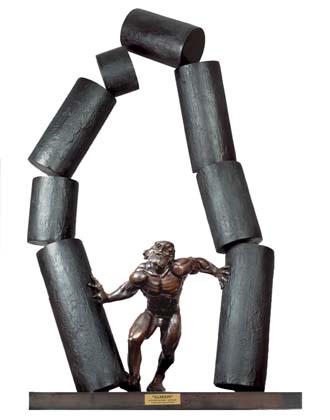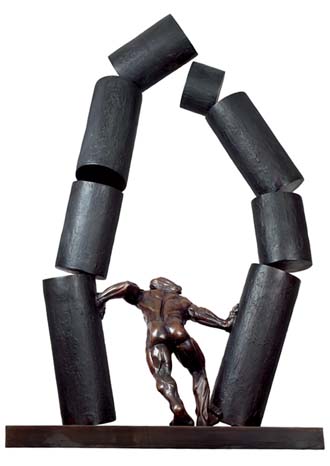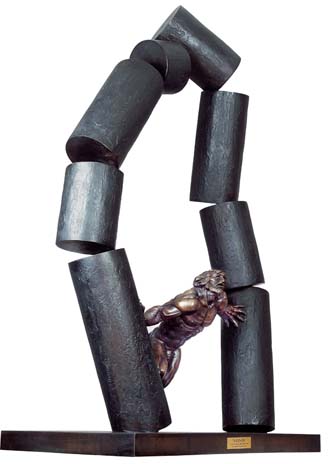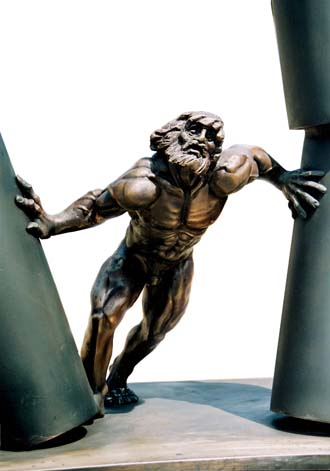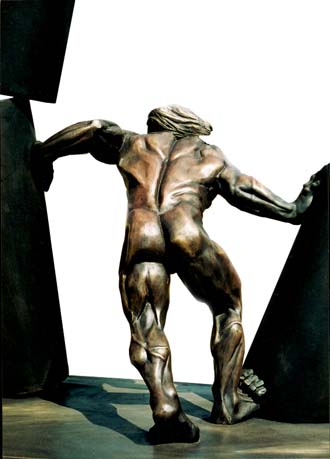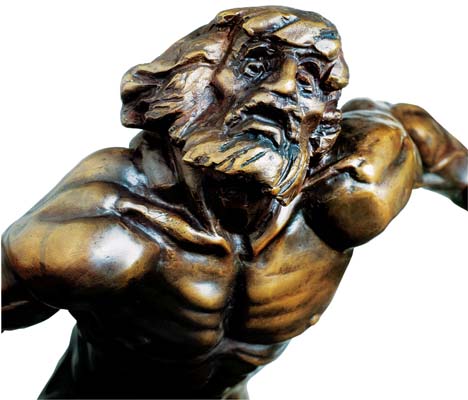|
RICHARD L. MINNS
artist
return
Samson's Final Moment
Large Bronze
Bronze, 140 high x 90 x 56 cm
(Base 80 x 56 cm), 2002
55.5 high x 35.5 x 22 inches (Base 31.5 x 22 inches)
Biblical Scripture:
“Now the temple was crowded with men and women; all the rulers of
the Philistines were there, and on the roof were about three thousand men and
women watching Samson perform. Then Samson prayed to the LORD, ‘O Sovereign
LORD, remember me. O God, please strengthen me just once more, and let me with
one blow get revenge on the Philistines for my two eyes. Then Samson reached
towards the two central pillars on which the temple stood. Bracing himself
against them, his right hand on the one and his left hand on the other, Samson
said, ‘Let me die with the Philistines! Then he pushed with all his might, and
down came the temple on the rulers and all the people in it. Thus he killed many
more when he died than while he lived.”
JUDGES 16:27-30
Description of Sculpture:
This is truly a 3-dimensional sculpture and must be viewed with
360-degree careful scrutiny. If you give it only a quick glance, you will surely
miss the experience. But if you stop, look carefully, walk around the sculpture,
and watch it change as you see it from different angles, you will make some
astonishing discoveries. If a viewer first encounters the sculpture up close,
the natural reaction is to step back to avoid the falling columns. It is
preferable to first view the sculpture from a distance, take in the silhouette,
and then walk up to it.
While it is preferable to display the sculpture
where a viewer can easily walk around it, Richard has installed a turntable
completely hidden inside the bronze base, so even if the sculpture is in the
corner of a room, it can easily be turned 360-degrees with one finger.
At first glance from a distance, the viewer
witnesses an architectural triumph. The architectural construction first hits
your eye. By utilizing a special bronze technique, the columns appear to be
actually falling and, if it were not for bronze welding, the columns would
indeed be falling. First, Richard utilized metal cylinders and welded them
together. Then they were polished, given the surface of ancient stone columns,
and a mold was made of this complicated structure so that it is now offered as
one single unit.
Richard's Samson is the embodiment of physical
force, portraying the Bible's strongest man in the world. Samson is leaning into
the columns, his left foot behind him, harnessing all the strength and force in
his body against the columns. His right foot presses against the column which
has already broken away from the floor. Samson's mighty shoulders and arms force
the columns apart.
As you turn the sculpture around on its turntable
you will note that, from Samson s toes to his fingers, from his calves to his
thick legs, powerful buttocks and explosive back, every muscle in his
magnificent body is in play, exerting his superhuman life force against the
columns.
Samson comes alive before your eyes. This is a
sculpture with maximum movement and compelling emotion. It is also believable.
Samson rushes into the columns like a pro-football linebacker and the columns
are falling. Step back. The columns may fall on you.
Artist's Interpretation:
“Samson is the Hercules of the Bible. He was not known for his
wisdom or his prophecies. He was known as the Bible's strongest man, for his
weakness for the wrong women, and for his legendary feats of strength. Unlike
David, who has been compared to Apollo, who was known for his physical
excellence and beauty, I see Samson as a basic Neanderthal force. Therefore, I
have emphasized Samson's upper body, his hands and his feet. This is more of a
caricature instead of the da Vinci-devised proportions of 8˝ heads to the body.
I wanted to capture the pathos on the face of a warrior blinded and humiliated
by his enemies, reflecting the anger, suffering and resolve of his tortured
soul.”
Richard Minns
|
 home
about
artists
exhibitions
press
contact
purchase
home
about
artists
exhibitions
press
contact
purchase